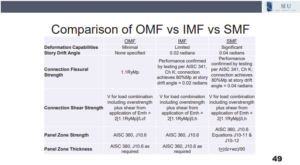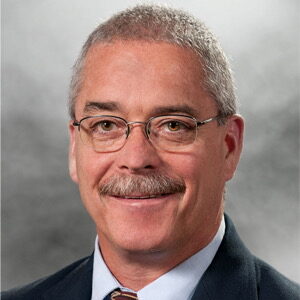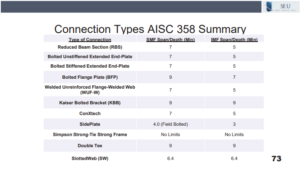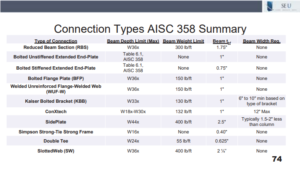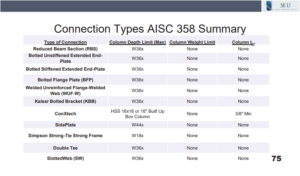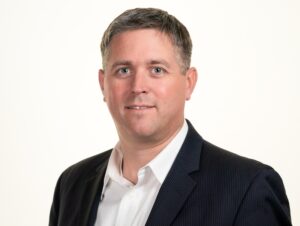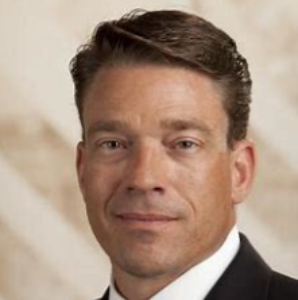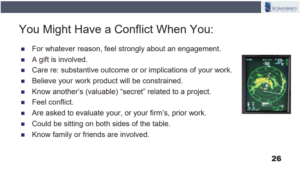Are you familiar with the similarities and differences between the various seismic moment frame systems allowed by code? As the seismic hazard increases, more ductility is required, but how is that accomplished?
In the March 2023 SEU session, Matt Mester, PE, SE, from MiTek, Inc., presented Steel Moment Frames: Design Principles & AISC 341/358 Provisions. Matt identified the four types of moment frames allowed by the building code, and how to choose a system based on the seismic criteria. He then reviewed the design provisions contained in AISC 341 for SMF, IMF, and OMF systems. Matt also reviewed the AISC 358 connection types and why you would choose one for your project.
Depending on your seismic criteria, some moment frame systems are more appropriate than others. Matt noted that, when allowed, most engineers will select an R=3 moment frame system which is not specifically required to be detailed for seismic resistance. These R=3 systems are only permitted in Seismic Design Categories A, B, and C with no limits on height, and are typically found in a wind governed structure. AISC 360 dictates the design of these systems, and the LRFD or ASD load combinations for both wind and seismic must be checked, however drift limits typically control the design.
For areas of higher seismic activity, the design category may push the EOR to select a moment frame system that is specifically designed and detailed for seismic resistance. The three options include R=3.5 Ordinary Moment Frames, R=4.5 Intermediate Moment Frames, and R=8 Special Moment Frames. The three systems are required to have explicit deformation capabilities, strength requirements, and connection detailing limitations. Matt included these helpful slides in his presentation which are a useful quick reference for breaking down the differences in these moment frame systems:
Using these chart comparisons, the EOR can identify the required drift angles, connection shear strength required, and various section references to find connection detailing requirements within the AISC 341 and 358. Matt noted that as the R value increases, the system ductility must increase, which leads to more stringent bracing and connection details which can be found in Chapter E of AISC 341. Being familiar with the differences between these systems can help engineers ensure compliance with the system ductility and drift requirements for their seismic moment frame projects.
22 Jun 2023
Material Testing of Existing Structures
Renovation projects are often complex endeavors in which engineers often lack pertinent structural information of the original design and any subsequent changes to the building. Investigating old records from previous owners, historical resources and searching for photographs taken during construction can be helpful; however, engineers typically need more definitive material specifications to ensure the capacity of the system can sustain new intended loads for the structure.
In the April 2023 SEU session, D. Matthew Stuart, PE, SE, P.Eng, F.ASCE, F.SEI, A.NAFE, from Partner Engineering and Science, Inc., presented Adaptive Reuse of the Historic Witherspoon Building. Matthew reviewed the different types of vintage structural components used at the historic Witherspoon building in Philadelphia, PA. He explained the different approaches used to determine the load carrying capacity of the existing floor and roof framing and talked about the historical reasons for the development and use of hollow clay tile arch framing systems.
Due to the age of the structure and lack of construction documents, the steel used on the project was tested to determine the actual yield strength to be used in the renovation design. After the presentation, Matthew was asked for guidance on coupon testing steel from an existing structure, and he provided some tips for successfully determining the yield strength.
Matthew noted that a steel coupon test only needs a sample about 2 inches wide and 6-8 inches long to perform the load test. Typically, the steel can be safely collected from redundant areas of the structure such as the bottom flange of a simply supported beam near the support or the bottom chord extension of an open web steel joist. Exploratory demolition may also be necessary to locate structural systems hidden behind walls or ceilings.
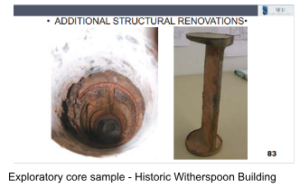 Lab testing can then be performed to determine the yield strength of the steel. Typical testing standards include ASTM A370 Standard Test Methods and Definitions for Mechanical Testing of Steel Products or ASTM E8 Standard Test Methods for Tension Testing of Metallic Materials at room temperature.
Lab testing can then be performed to determine the yield strength of the steel. Typical testing standards include ASTM A370 Standard Test Methods and Definitions for Mechanical Testing of Steel Products or ASTM E8 Standard Test Methods for Tension Testing of Metallic Materials at room temperature.
It is common during reuse or renovation projects to be without necessary design information from the original construction. While educated design assumptions based on historical data must be used, material lab testing ensures designers do not use overly conservative assumptions, and can maximize the capacity of the structural system being repurposed.
In April 2023, D. Matthew Stuart, PE, SE, PEng., F.ASCE, F.SEI, A.NAFE, from Partner Engineering and Science, Inc., presented Adaptive Reuse of the Historic Witherspoon Building. Matthew nominated the United Methodist Committee on Relief (UMCOR) (UMCOR – Global Ministries (umcmission.org)) for the SEU Speaker Inspires donation of the month.
According to it’s mission statement, UMCOR is the humanitarian relief and development arm of The United Methodist Church and it assists churches to become involved globally in direct ministry to persons in need. UMCOR comes alongside those who suffer from natural or human-caused disasters – famine, hurricane, war, flood, fire or other events—to alleviate suffering and serve as a source of help and hope for the vulnerable. UMCOR provides relief, response and long-term recovery grants when events overwhelm a community’s ability to recover on their own. UMCOR also provides technical support and training for partners to address emerging and ongoing issues related to disaster relief, recovery, and long-term health and development.
Thank you, Matthew, for helping structural engineers with your SE University session, and for your designation of the United Methodist Committee on Relief as our SEU Speaker Inspires Organization of the Month!
SE University began the SEU Speaker Inspires program in 2015 as a way to “pay it forward”, enabling our speakers to designate a charity/organization of their choice for SE University to make a donation to help improve our world.
In March 2023, Matthew Mester, PE, SE, from MiTek, Inc., presented Steel Moment Frames: Design Principles & AISC 341/358 Provisions. In 2017, he nominated the Structural Engineers Association of Southern California Foundation (http://www.seaosc.org) for the SEU Speaker Inspires donation of the month, and he has chosen to do the same in 2023.
The Structural Engineers Association of Southern California Foundation, in its goals to further the development of the structural engineering profession, looks for partners, be it individuals, companies or corporations, to pursue structural engineering innovation and research for use in the public domain. The foundation can assist in the development process of specific structural engineering research projects and publishing of any findings.
The foundation is dependent upon donations for its operation and funding of research projects and annual student scholarships. Matthew chose to donate to the SEAOSC Foundation for student scholarships to “help the next generation of structural engineers.”
Thank you, Matthew, for helping structural engineers with your SE University session, and for your designation of the Structural Engineers Association of Southern California Foundation as our SEU Speaker Inspires Organization of the Month!
SE University began the SEU Speaker Inspires program in 2015 as a way to “pay it forward”, enabling our speakers to designate a charity/organization of their choice for SE University to make a donation to help improve our world.
30 May 2023
AISC 358 Connection Type Limits
Intermediate Moment Frame systems and Special Moment Frame systems have stringent connection detailing specifications and limits. Selecting the best prequalified connection for your system can be confusing given the many stipulations and options available.
In the March 2023 SEU session, Matt Mester, PE, SE, from MiTek, Inc., presented Steel Moment Frames: Design Principles & AISC 341/358 Provisions. Matt identified the four types of moment frames allowed by the building code, and how to choose a system based on the seismic criteria. He then reviewed the design provisions contained in AISC 341 for SMF, IMF, and OMF systems. Matt also reviewed the AISC 358 connection types and why you would choose one for your project.
Matt included some very useful slides in his presentation which summarize the limitations for the prequalified connection contained in AISC 358. The limitations include span/depth ratios, beam and column depth and weight limits, as well as flange thickness limits as shown in the slides below:
These useful charts are a great quick reference when you need to identify which prequalified connection might work best given certain beam and column sizes on your next project. Click on the slide to print a PDF copy to keep on hand when you start detailing your next IMF or SMF project.
In February 2023, SEU welcomed Matthew Rechtien, PE, Esq., from Walter P. Moore, to present 2023 Engineering Ethics Update: Conflicts of Interest. In prior years, Matt has designated Friends of Perryville Battlefield (https://www.friendsofperryville.org) for our SEU Speaker Inspires donation for the month and he has chosen to do the same in 2023.
Matt shared, “On October 8, 1862, nearly 8,000 Americans fell in the drought-parched Chaplin Hills of Kentucky during the Battle of Perryville. Perryville played a pivotal role in our nation’s most impactful event. Although the clash is oft-forgotten, those Americans should be remembered and that sacred ground, one of the most pristine civil war battlefields remaining, should be protected. The Friends of Perryville Battlefield is committed to both missions, which I am humbled to advance.”
Thank you, Matt, for helping structural engineers with your SEU session, and for your designation of Friends of Perryville Battlefield as our SEU Speaker Inspires Organization of the Month!
SEU began the SEU Speaker Inspires program in 2015 as a way to “pay it forward”, enabling our speakers to designate a charity/organization of their choice for SEU to make a donation to help improve our world.
25 Apr 2023
Spring Clean your LinkedIn Profile
When was the last time you revamped your LinkedIn profile? So many engineers only update this vital contact tool when they move or change employment status, but LinkedIn offers more benefits than simply providing contact and employment information.
LinkedIn is often the easiest way to find old colleagues that you may have lost contact with due to the boost LinkedIn profiles receive in search results on search engines. This added visibility should make each user realize the importance of maintaining their LinkedIn profiles. At the very least, your profile should include up-to-date employment information, job title, and current professional photo. However, there are so many other ways LinkedIn can benefit your professional brand.
Considering that most employers also have LinkedIn accounts, it could be a wise career choice offer to help your employer maintain content. Providing updates on current jobs under construction, or photos from a recent team-building event could show your commitment to your employer and enhance your visibility in the workplace.
LinkedIn is a great tool to keep abreast of new developments within your industry and maintain contact with professionals who you may have had a brief introduction at a conference, but would otherwise lose touch with. However, this requires frequent use of monitoring posts by other groups and contacts, and responding to their achievements or announcements. If you only check your profile when something on your end has changed, you miss the benefit of connecting with others when they have significant changes in their careers.
Updating your profile can lead to conversations that you may not have considered. Taking the time to list your skills and recent accomplishments really affect your professional brand and will be noted by others that you don’t even realize. You may be quite content in your job and not looking to be approached by recruiters, but LinkedIn has eclipsed as more than just a tool for recruiters. Your professional profile shows your perspective on your career, and it would be wise to make that perspective meaningful to the many people viewing your profile, as you read this!
27 Mar 2023
“SEU Speaker Inspires” Organization of the Month: SEAONC Diversity in Structural Engineering Scholarship
In January 2023, SEU welcomed Kevin S. Moore, PE, SE, from Simpson, Gumpertz, & Heger, to present What a Structural Engineer Should Know about Resilience. Kevin has designated SEAONC Diversity in Structural Engineering Scholarship (http://www.ncsea.com/about/foundation/diversityscholarship/) for our SEU Speaker Inspires donation for the month.
Kevin shared, “The opportunity to increase funding in a permanent endowed scholarship that financially supports a student from an historically underrepresented minority in structural engineering, preferably with a desire to practice in northern California, is a very small but rewarding privilege. Thousands of capable students desire a rewarding career in our noble profession, but often face unfair challenges and financial shortfalls that fail to cover costs associated with very expensive university programs. Scholarships like this help bring some amount of equity to students that have done so much themselves. I am proud to be a part of a community that cares enough to contribute and even happier that SEU sees the value in doing the same.”
Thank you, Kevin, for helping structural engineers with your SEU session, and for your designation of SEAONC Diversity in Structural Engineering Scholarship as our SEU Speaker Inspires Organization of the Month!
SEU began the SEU Speaker Inspires program in 2015 as a way to “pay it forward”, enabling our speakers to designate a charity/organization of their choice for SEU to make a donation to help improve our world.
27 Mar 2023
Tips for Spotting Conflicts of Interest
How do you know if a conflict of interest arises on a project? Are you familiar with the ethical rules you may be subject to, and the ways to address potential conflicts?
In the February 2023 SEU session, Matthew Rechtien, PE, Esq., from Walter P Moore, presented 2023 Engineering Ethics Update: Conflicts of Interest. Matt defined conflicts of interest and explained why ethics rules regulate conflicts. He also covered the basics of conflicts rules, how to apply them, and how to identify conflicts.
Matt shared some helpful tips for identifying conflicts of interest. He noted several situations which could result in a conflict of interest as shown on the following slide:
Matt noted that not all of these situations prove that a conflict exists, however, they should cause a moment of pause to consider if a conflict does exist. If a conflict is identified, engineers should refer to the ethical guidelines to which they are bound by their licensing boards and/or professional organizations. As Matt said, it is more prudent for the engineer to make any potential conflict known to the clients, rather than have to defend their actions to a board at a later point.
Identifying a conflict of interest does not mean the engineer cannot be involved on a project. Depending on the ethics rules in their jurisdiction, engineers may be able to proceed once the conflict is disclosed, but at the very least, a disclosure is typically necessary if there is a potential for conflict. Using the above tips, engineers can more accurately assess when conflicts might arise in their future projects, and proceed with a bit of caution.
27 Mar 2023
Conflict of Interest or Not?
Have you worked on the same project more than once? Or have you been solicited to perform work on a previous job by a new client? When does a conflict of interest exist when working on a similar or same project? What duty does the professional engineer have to disclose any potential conflicts?
In the February 2023 SEU session, Matthew Rechtien, PE, Esq., from Walter P Moore, presented 2023 Engineering Ethics Update: Conflicts of Interest. Matt defined conflicts of interest and explained why ethics rules regulate conflicts. He also covered the basics of conflicts rules, how to apply them, and how to identify conflicts.
From his experience working as an attorney and engineer, Matt shared several common examples of conflicts of interest that structural engineers can be faced with. One example he proposed involves successive engagements on a project. To hear Matt’s reasoning on whether this common occurrence presents a conflict of interest, watch this short 6 minute video:
Engineers should maintain familiarity of the ethical rules to which they are bound by state law and also by professional boards. These rules can vary widely by state and may have specific requirements when a conflict of interest is identified. Both ASCE and NSPE specifically address conflicts of interest in their ethics code and both require engineers to disclose any potential conflicts.
Ethics rules exist to protect the client and the engineer from conflicts of interest which could impede the engineer’s judgment on a project. Matt noted that conflicts of interest are among the most common ethical issues faced by engineers, thus, the professional engineer is wise to identify any conflicts early and seek counsel before proceeding on the project.

